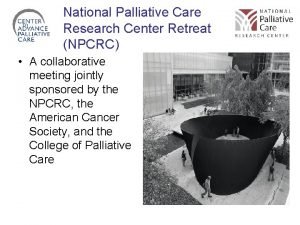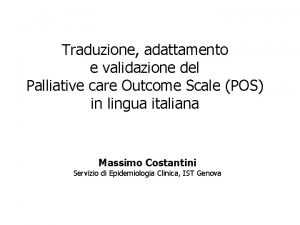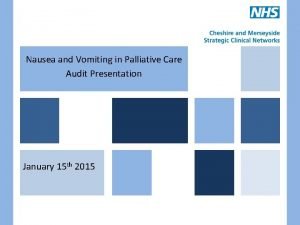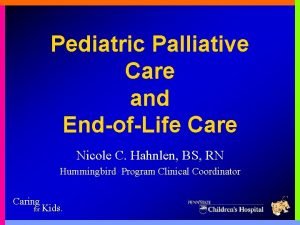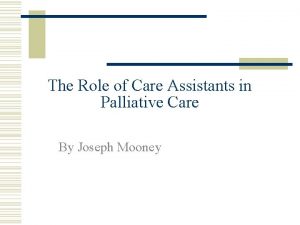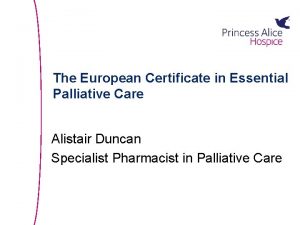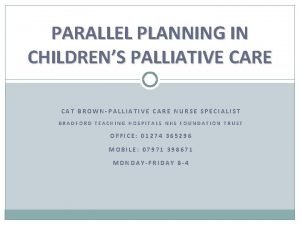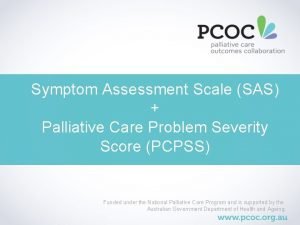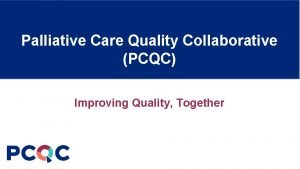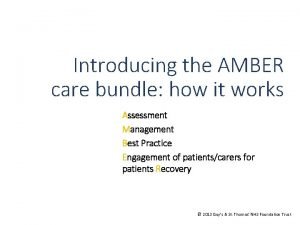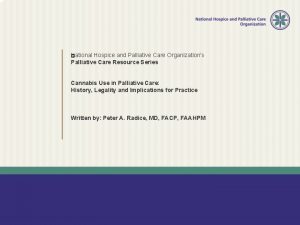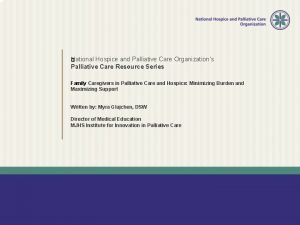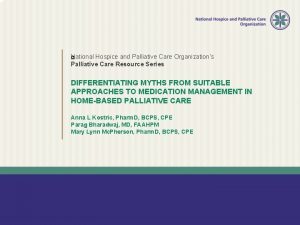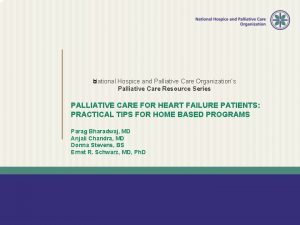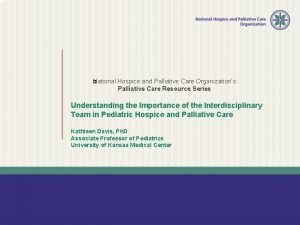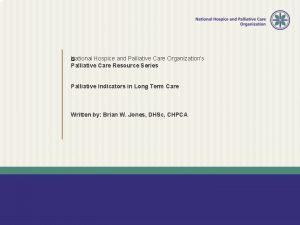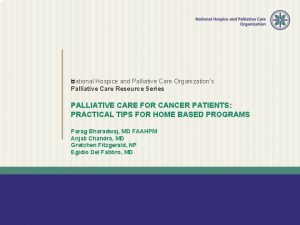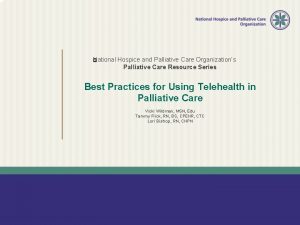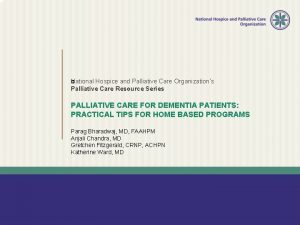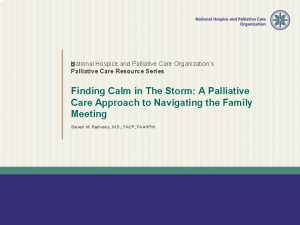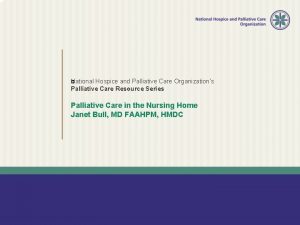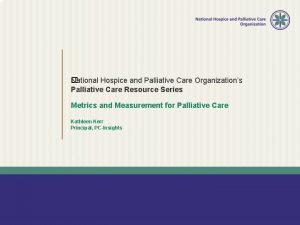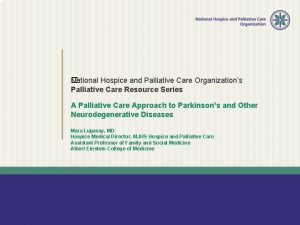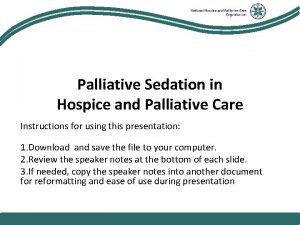National Hospice and Palliative Care Organizations Palliative Care

















- Slides: 17

National � Hospice and Palliative Care Organization’s Palliative Care Resource Series Hospice-Hospital Collaborations: Making the Case to Hospital Administrators Todd Cote, MD

Objectives • R �eview the current hospital environment and types of hospicehospital collaborations. • Discuss benefits, barriers and challenges of hospice-hospital collaborations. • Present strategies to build a case to hospital administrators.

Current Hospital Environment • • �ocused on internal and external quality improvement F Interested in value added programs (Value=Quality/Cost) Data-driven Government mandates from health care reform: – Readmission rates – Mortality index (observed deaths/expected deaths) – Patient satisfaction ratings

Types of Collaboration Independent Contracts with Hospitals • Medicare Hospice benefit (MHB) Hospice General Inpatient Care (GIP) • Hospice liaison nurse/ hospice inpatient team

Types of Collaboration Extensive contracts • Hospice program within/or part of a hospital organization or hospital system: – – Inpatient hospice and/or palliative care units Small scale comfort suites Palliative care consultation teams Hospice may be subsidiary company under hospital system

Types of Collaboration Contracts to Support End-of-Life Services • EOL education programs • Ethics committee membership • Palliative care coordinating committee • Case management • Advance directive programs

Benefits of Collaboration Hospice • Increase access to more patients • Learn about hospital care • Timely referrals

Benefits of Collaboration Hospital • Improve quality of EOL care • Learn about hospice • Improve continuity of care • Improve branding and patient satisfaction

Barriers and Challenges Legal, Regulatory and Financial • Conditions of Participation: acute care hospital versus hospice(level of care/benefit periods/eligibility/relatedness) • The OIG and ‘Others” • Certificate of Need • Hospice competition • Budgetary restraints • Varying payment schemes

Barriers and Challenges Systemic Process • Electronic medical record • Documentation requirements, workforce after hour call, clinician credentialing • Bed management logistics • Transitioning patients out of hospital to hospice

Barriers and Challenges Institutional Culture • Quality of end-of-life care in hospitals is slow to improve • Denial of death • Lack of education

Making a Case to Hospital Administrators • True Partnerships • Respect and understanding from each organization and their leaders • Hospice and hospital champions • Outstanding clinical leadership

Know Your Hospital and Hospital Administrator When you’ve seen one hospital, you’ve seen one hospital! • Understand overall mission and vision • Research the administrator – background, experience with hospice, etc. • Assume nothing! Fully explain hospice the MHB and the Co. Ps

Know What the Hospital Needs • Ask administrators! • Understand government mandates – hospital re-admissions, mortality index, patient satisfaction scoring • Address end-of-life care within the hospital • Gather data showing how hospices are servicing hospitals – national, Medicare data-mining and private firms.

Examples: Evidence Based Data • Palliative Care Services in the hospital can reduce hospital cost. (Prevent unnecessary inpatient utilization: ↓ LOS, ↓ Ancillary charges). • Post-hospitalized patients referred to hospice have lower readmission rates. • Re-hospitalization care of hospice patients is costly to the hospital. • Education and comfort care order sets improve end of life care for patients dying in a hospital. • Hospice can improve patient/family satisfaction.

Know What the Hospice Can Do • • �imited hospice budget L Expert level workforce Consideration for 24/7 services and on-call Hospice competition – healthy vs unhealthy

Conclusion • H �ospice–Hospital collaborations are important for the future of end-of-life care and can be a win-win for both organizations. • Collaboration involves proper planning, knowledge and leadership. • Financial sustainability is feasible but requires a true partnership based on mutual respect and support.
 Palliative care vs hospice care
Palliative care vs hospice care Franciscan palliative care
Franciscan palliative care National palliative care research center
National palliative care research center Bluegrass palliative care
Bluegrass palliative care Hospice care traduzione
Hospice care traduzione Palliative care antiemetics
Palliative care antiemetics Edmonton symptom assessment system
Edmonton symptom assessment system Rug adl
Rug adl Hospice satisfaction survey
Hospice satisfaction survey Principles of palliative care
Principles of palliative care Palliative care in nepal
Palliative care in nepal Palliative care assistant
Palliative care assistant European certificate in palliative care
European certificate in palliative care Parallel planning palliative care
Parallel planning palliative care Sas scale
Sas scale Pcqc
Pcqc Just in case bag palliative care
Just in case bag palliative care Amber palliative care
Amber palliative care


